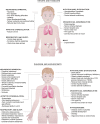Requirements for improving health and well-being of children with Prader-Willi syndrome and their families
- PMID: 31257692
- PMCID: PMC6852695
- DOI: 10.1111/jpc.14546
Requirements for improving health and well-being of children with Prader-Willi syndrome and their families
Abstract
Prader-Willi syndrome (PWS) is a rare genetic condition with multi-system involvement. The literature was reviewed to describe neurodevelopment and the behavioural phenotype, endocrine and metabolic disorders and respiratory and sleep functioning. Implications for child and family quality of life were explored. Challenging behaviours contribute to poorer well-being and quality of life for both the child and caregiver. Recent evidence indicates healthy outcomes of weight and height can be achieved with growth hormone therapy and dietary restriction and should be the current target for all individuals with PWS. Gaps in the literature included therapies to manage challenging behaviours, as well as understanding the effects of growth hormone on respiratory and sleep function. New knowledge regarding the transition of children and families from schooling and paediatric health services to employment, accommodation and adult health services is also needed. Developing a national population-based registry could address these knowledge gaps and inform advocacy for support services that improve the well-being of individuals with PWS and their families.
Keywords: Prader-Willi syndrome; endocrine; hyperphagia; quality of life; sleep disordered breathing.
© 2019 The Authors. Journal of Paediatrics and Child Health published by John Wiley & Sons Australia, Ltd on behalf of Paediatrics and Child Health Division (The Royal Australasian College of Physicians).
Figures


References
-
- Lionti T, Reid SM, White SM, Rowell MM. A population‐based profile of 160 Australians with Prader‐Willi syndrome: Trends in diagnosis, birth prevalence and birth characteristics. Am. J. Med. Genet. A 2015; 167A: 371–8. - PubMed
-
- Driscoll DJ, Miller JL, Schwartz S, Cassidy SB. Prader‐Willi syndrome In: GeneReviews. Seattle, WA: University of Washington; 1998. Available from: https://www.ncbi.nlm.nih.gov/books/NBK1330/ [accessed 16 May 2019].
-
- Lionti T, Reid SM, Rowell MM. Prader‐Willi syndrome in Victoria: Mortality and causes of death. J. Paediatr. Child Health 2012; 48: 506–11. - PubMed
-
- Grugni G, Crino A, Bosio L et al The Italian National Survey for Prader‐Willi syndrome: An epidemiologic study. Am. J. Med. Genet. A 2008; 146A: 861–72. - PubMed
Publication types
MeSH terms
Grants and funding
LinkOut - more resources
Full Text Sources
Medical

